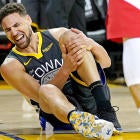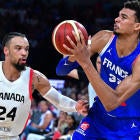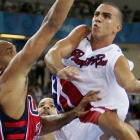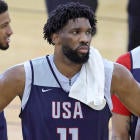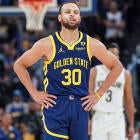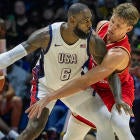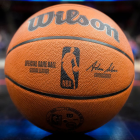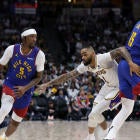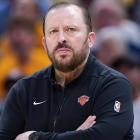When Klay Thompson went down with a torn left ACL in Game 6 of last season's NBA Finals, the Golden State Warriors were, potentially, en route to forcing a Game 7 after falling behind to the Raptors 3-1 in the series. After staving off elimination with a Game 5 won on the heels of Kevin Durant tearing his Achilles tendon, the Warriors were up five late in the third quarter when Thompson limped off the court after making his two free throws.
Thompson was cooking with 30 points in 32 minutes to that point, and he recently said he believes the Warriors, who were at home, would have finished that game off and eventually won the series in Game 7 had he not gotten hurt.
"In my mind, yes, we would've won if I didn't get hurt," Thompson told Marcus Thompson of The Athletic. "But that's just the nature of sports, you know? What-ifs? It doesn't matter. It's if you do your deed or not. In my mind, I think we would've. But you never know. That's the hard part you've got to accept. I look at all the guys who had bad luck getting injured against us the last few years, and I've honestly become so much more sympathetic. Yeah. That's just the nature of the beast."
Of course Thompson is going to believe the Warriors would've won, but that's neither here nor there at this point. They didn't win, Durant left, and as it stands not many people are expecting the Warriors to remain atop the championship conversation -- if they even remain in it at all.
Thompson being out for at least an extended portion of this coming season clearly has a lot to do with the lowered expectations. But how long, exactly, will he be out? Nobody can say for sure, but a recent article by Heavy.com's Sean Deveney suggested a very ominous forecast for Thompson and Warriors fans.
A paper presented by Dr. Tim Hewett, a consultant who spent the bulk of his career studying the biomechanics of the knee for the Mayo Clinic and as the director of Ohio State's Sports Health and Performance Institute, and Dr. Christopher Nagelli of the Mayo Clinic, finds that athletes who suffer ACL tears should not return to action for two years.
"Please do share that with Klay," Dr. Hewett, who has consulted with NBA trainers in the past, told Heavy.com. "This is not my opinion. People say to me, 'Well, that is your opinion, there are other opinions.' No, I deal in science and I deal in fact. People don't like to hear it but it does not change the facts, and that facts are that you're at risk for re-injury before two years and you won't be the same player in the first year."
"It's not just psychological," Hewitt continued. "It is physical, too. Your graft is still mush. You are grafting a piece of tendon onto the ACL in that surgery. It takes 18-24 months for a grafted ligament to re-ligamentize, to mature to the point where it is something close to a baseline of where it was before. If you are playing before that, you're playing on a ligament that's not done healing."
The Warriors are going to be careful and conservative with Thompson's return. For starters, they are an extremely mindful, analytical organization when it comes to injuries and injury prevention to begin with. Besides that, they just inked Thompson to a five-year, $190 million max extension and obviously want to protect their long-term investment. Plus, we all know what happened when Durant came back too soon from his strained calf, which clearly wasn't fully healed, and wound up tearing his Achilles.
Prior to Durant suffering that catastrophic injury, in the time he was rehabbing the strained calf and speculation was growing as to when, or if, he would return, CBS Sports spoke with Dr. Alan Beyer, an orthopedic surgeon and the executive medical director at Hoag Orthopedic Institute in Southern California, about the dangers of Durant returning too soon and the precarious nature of his particular injury. In hindsight, his warning is almost eerie.
"With a weakened calf, you're worried about significant re-injury and even tearing the Achilles tendon further down," Dr. Beyer told CBS Sports, and unfortunately, he was right. On Monday, I asked Dr. Beyer if he agreed with the idea that Thompson, or any high-level athlete who has suffered a torn ACL, would need to sit out 18 months to two years for that ligament to fully heal.
"No, I don't agree with that at all," Dr. Beyer told CBS Sports. "Think about how many ACL injuries we've seen over the years, and how many high-level athletes stay out for two years. I can't think of one. Nine to 12 months is the general window. If this two-year premise were true, we would obviously be seeing a swath of re-injuries in that one- to two-year period. But we don't see that."
To that point, here is a list, per ACL Recovery Club, of every NBA player who tore his ACL from 1970 to 2014. Notice that of the 86 names, only six have suffered a re-injury.
Here's the list of NBA players that have torn their ACL (1970-Present) #ACLfraternity @RealJayWilliams @Baron_Davis pic.twitter.com/Uf3Sjs1lTS
— ACL Recovery Club (@ACLrecoveryCLUB) May 22, 2014
All told, 105 players have torn their ACL since 1970, with just nine suffering a re-injury -- and as we're about to show, even that number is deceiving, if not outright faulty information. To narrow the focus to recent injuries, 35 players have suffered torn ACLs over the past decade, and the Heavy.com article points to the three names who have done it twice: Jabari Parker, Josh Howard and Michael Redd. But what the article doesn't tell you is that Parker's torn ACLs happened more than two years apart, and Howard's were in two separate knees.
That leaves Redd's case as the only one that holds water as a repeat ACL offender within the two-year frame, as he tore his ACL and MCL in January of 2009 then tore both the same ligaments again, in the same knee, almost exactly one year later. Recalculate, and out of 35 ACL tears over the past decade, that's one potentially linked re-injury within a two-year time frame -- less than a three-percent re-injury rate. According to Dr. Beyer, even if it were a 10 percent re-injury rate, that would be "acceptable" at the professional level. It's not even close to that, and again, nobody sits out two years.
Below are Dr. Beyer's comments on the difference between the "true biology" and the functionality of a recovered ACL, why the two-year window stems from the former, and what it all means in terms of when we can expect Klay Thompson back in the court:
"Waiting two years to come back, for a high-level athlete in the prime of their career, is almost never seen, if it ever is, and it's totally unnecessary," Dr. Beyer told CBS Sports."In fact, it may be even worse to wait that long in some cases. The reason I say that is the best way to get a ligament, or a bone, or any biological tissue that is healing, to heal faster is to stress it and keep upping that stress. That's what brings in optimal blood flow, and when you're staying off an injured area to a large degree, atrophy just continues to set in with those supporting structures around the injury.
"Now, in terms of the actual science, we have known for years that it takes at least a year for a rebuilt ACL to fully vascularize, for all the blood vessels to grow into the new ligament and for it to have as good of blood supply as an uninjured ACL," Dr. Beyer went on. "So when you say it could take up to two years for a torn ACL to be fully healed, yes, the true biology on that is technically correct. In other words, if you're looking at that repaired ligament under a microscope, yeah, OK, it doesn't look like a normal ACL at 12 months or 18 months.
"But what I'm saying -- and again, the extreme lack of re-ruptures that occur in that one- to two-year period supports this -- is that the ligament doesn't have to look like a completely new ligament under a microscope, with all new tissue and completely re-attached blood vessels, to be able to use it. There is no data to back that up. The concern is the ligament itself, and that's a strong ligament with a lot of bulk. It's not some piece of thread in there holding everything together. We tend to be using a portion of the quadriceps tendon now to do our ACL reconstructions in big athletes. It has significant strength and ability to withstand forces.
"Again, nine to 12 months is the return window if there aren't any setbacks," Dr. Beyer concluded. "Thompson was injured in June, that wold put him back around March on the front end of that. Certainly by the playoffs is very reasonable."
So, don't panic, Warriors fans. Assuming your team is in the playoffs, there's a very good chance Thompson will be ready to go. Now, what level he'll be able to play at after such a long layoff is another question.









